(10 am. – promoted by ek hornbeck)
Burning the Midnight Oil for Living Energy Independence
 Express HSR is sexy. Indeed, its sexy enough that when Big Oil propagandizes against it, they have to paint it as too expensive or something that America is too incompetent to handle, since the idea of sitting in an actually comfortable rail seat, watching a movie on a laptop or snacking on a sandwich while flying along at two to three times highway speeds, “just like in France or Japan or Spain”, that’s too appealing to convince a big majority of people that it would be anything but nice to have. So they have to con people into thinking of it as an unrealistic pipe dream that the US can do what Spain has been doing for a decade, France for three decades, and Japan for half a century.
Express HSR is sexy. Indeed, its sexy enough that when Big Oil propagandizes against it, they have to paint it as too expensive or something that America is too incompetent to handle, since the idea of sitting in an actually comfortable rail seat, watching a movie on a laptop or snacking on a sandwich while flying along at two to three times highway speeds, “just like in France or Japan or Spain”, that’s too appealing to convince a big majority of people that it would be anything but nice to have. So they have to con people into thinking of it as an unrealistic pipe dream that the US can do what Spain has been doing for a decade, France for three decades, and Japan for half a century.
Rapid Rail is not as sexy as Express HSR, but at least it is as fast as driving for most drivers on most corridors, and appreciably faster than driving on the corridor with the “best bones”, like either Cleveland / Columbus or Davenport / Des Moines / Iowa wold be at 110mph top passenger speed. And it is much cheaper than Express HSR, with lots of potential corridors that local residents will start lobbying for once the first of the Rapid Passenger Rail services come into service.
But conventional long haul rail? Surely plodding along at 50mph to as slow as 30mph on heavy freight rail corridors is an obsolete holdover from an earlier time?
Well, no. Conventional long haul rail has a 21st century role to play, if the United States should declare Economic Independence and start working to regain the economic freedom that we surrendered to the Big Oil and the oil exporting regions in the 70’s and 80’s.
And so, in this evening’s Sunday Train, we look at the “PRIIA Section 210” plans that Amtrak has developed for the five weakest of its fifteen long distance corridors: the California Zephyr, the Capitol Limited, the Cardinal, the Sunset Limited, and the Texas Eagle.
The PRIIA Section 210 Process
The four working group reports produced for these five corridors all share the same introductory boilerplate language to describe what is going on:
Section 210 of the Passenger Rail Investment and Improvement Act of 2008 (PRIIA) requires Amtrak to identify the lowest performing third of the fifteen long distance routes in 2010 and develop a plan to improve the overall results of their financial, on-time performance, service related, and customer satisfaction targets. Amtrak will work on the middle ranked and top ranked trains in 2011 and 2012 respectively. The five routes identified for FY10, based on a combination of FY08 Attributed Cost Recovery, Customer Satisfaction Index (CSI), and on-time performance are the Sunset Limited, Texas Eagle, California Zephyr, Cardinal, and Capitol Limited.
…
Section 210 requires Amtrak to embark on a comprehensive program to improve its long-distance services. Starting in FY10 with the five worst performing routes, Amtrak formed cross-departmental Performance Improvement Teams to explore every aspect of the routes’ operations. By the end of the fiscal year, Amtrak will make recommendations based on in-depth analyses of the long-distance routes in nine key areas. These areas are:
- On-time performance
- Scheduling, frequency, routes, and stops
- Feasibility of restructuring the route into connected corridor services
- Performance-related equipment changes and capital improvements
- Onboard amenities and service including food, first class, and sleeping car service
- State or other non-Federal financial contributions
- Improving financial performance
- Anticipated Federal funding of operating and capital costs
The reason that there are five corridors and four reports is that the Texas Eagle and Sunset Limited routes are partially integrated, with a set of passenger rail cars handed off from the Texas Eagle at the end of its route to the Sunset Limited for through service to Los Angeles, and then collected again on return eastbound from LA to connect through to Chicago on the Texas Eagle.
Fixing up the Cardinal
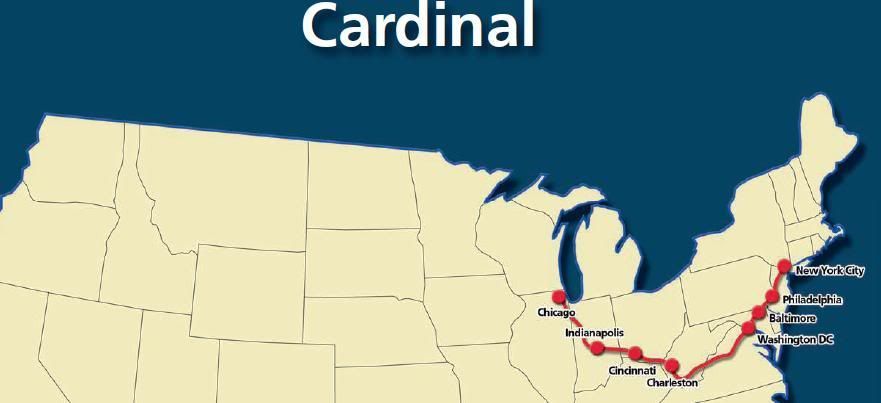 The Sunday Train has looked at the Cardinal several times, as the only existing East/West service through Central Appalachia. The Cardinal presently runs three times a week “the long way around” between New York and Chicago, via Washington DC, western Virginia, West Virginia, northern Kentucky, Cincinnati, and Indiana. The Cardinal comes fourteenth among the fifteen long haul routes in terms of combined passenger satisfaction, on-time performance and farebox recovery, with a 66% customer satisfaction index (CSI), 31% on-time performance (OTP), and 35% cost recovery (CR).
The Sunday Train has looked at the Cardinal several times, as the only existing East/West service through Central Appalachia. The Cardinal presently runs three times a week “the long way around” between New York and Chicago, via Washington DC, western Virginia, West Virginia, northern Kentucky, Cincinnati, and Indiana. The Cardinal comes fourteenth among the fifteen long haul routes in terms of combined passenger satisfaction, on-time performance and farebox recovery, with a 66% customer satisfaction index (CSI), 31% on-time performance (OTP), and 35% cost recovery (CR).
Because the Indianapolis / Chicago service is provided by the Hoosier service on the days that the Cardinal does not run, the working group considers the Cardinal and the Hoosier together: any substantial change to the Cardinal would require the Hoosier to fall in line.
Since the Capitol Ltd offers a faster trip DC/Chicago, and the Lakeshore Ltd a faster trip NYC/Chicago, the Cardinal has very little end to end patronage. Its largest trip generators (by head count rather than passenger miles) are 12% Chicago / Indianapolis, 9% Chicago / Lafayette, IN, 6% Chicago / Cincinnati, about 3% each DC / Charlottesville, DC / Cincinnati, Chicago / Charlottesville, and Chicago / DC, with 61% of total trips represented by smaller individual trip markets. It serves Marshall, Purdue, and Indiana University, among other universities (but not Miami University, despite running through Oxford, Ohio in the middle of the night).
Although considering a range of alternatives, the simplest fundamental improvement proposed for the Cardinal is the simplest: replace the tri-weekly Cardinal and four-times-weekly Hoosier state with a daily Cardinal. Each Cardinal service requires one diesel locomotive, one baggage car, one diner/lounge car, and three coach cars. The Hoosier State consists of one locomotive and two coach cars. And given that the Cardinal runs 26hrs per one-way trip, three Cardinal trains are sufficient for daily service. So the equipment requirements to basically upgrade the Hoosier State corridor coach train into the required third Cardinal train for daily are one each of a sleeper car, baggage car, diner/lounge, and coach.
Because the Cardinal passes through height-limited tunnels on its way to NYC, this has to be single level “Viewliner” equipment. And, what do you know, but thanks to the record Amtrak ridership this past few years, there will shortly be some new single-level Viewliner equipment available:
Amtrak awards $298.1 million contract to CAF USA for 130 rail cars
On Friday, Amtrak announced it’s implementing the first step in a 30-year rail-car fleet renewal plan by purchasing 130 new single-level cars for long-distance services.
…
The order includes 55 baggage, 25 baggage/dormitory, 25 sleeping and 25 diner cars. … The cars will feature more modern interiors with better layouts, upgraded lighting and more efficient air conditioning and heating systems, and improved accessibility for disabled passengers.Revenue – which is surpassing budget estimates in part because of record ridership – will cover the contract’s first-year total of $29.8 million; funding for subsequent years will be sought from other sources, such as loans or direct Congressional appropriations, Amtrak officials said.
Critically, the current cars used on the Amtrak Regionals cannot operate at 125mph, so one priority will be to not just replace the oldest of the existing Heritage fleet, some of it dating back to the 1940’s and 1950’s, but to form Amtrak Regional trains that will be capable of up to 125mph when running along the electrified NEC corridor. Cherry picking the best of the current rolling stock that is being rotated out of service in the Northeast for one each baggage car, sleeping car, diner/lounge and coach
Also, while not a formal part of the PRIIA Part 210 analysis, the Hoosier State is the type of corridor service that states are supposed to take over funding … and it is highly likely that Indiana will refuse to pay. So
And the financial impact? According to Amtrak projections, switching to daily service will boost ridership by 96%, and increase passenger miles per train mile by 15%, while increasing cost by . Meanwhile it will increase increase operating costs by about 42%. The net result is an increase in direct loss on the service by $1.1m, from $19.5m to $21.6m, and with the near doubling of ridership, farebox recovery is expected to increase by 8% points, and subsidy per passenger mile to drop from $0.42 to $0.29.
There are other service changes covered in the report — including more modestly priced menu choices in the diner car, ongoing work to reduce slow orders along the corridor, re-arranging servicing to have more work done overnight in New York, where there is greater experience working with single level trains than in Chicago — but the upgrade to daily is the big one. This was held up by Congress refusing to fund the order of new Viewliners, but now that Amtrak revenues are exceeding expectations, and new cars will start to be delivered this Fall, we could well see a daily Cardinal by the New Year.
Texas Eagle / Sunset Limited
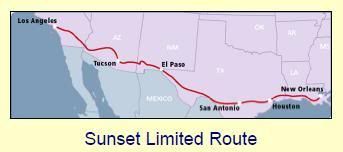
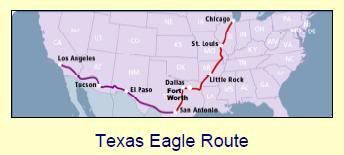
The Sunset Limited is another one of the struggling tri-weekly services. When it does run, it collects through passenger cars from the daily Texas Eagle — which Kay Bailey Hutchinson worked hard and successfully to rescue the last time it was under threat — in San Antonio. And therein lies a key problem with the service:
Over the years, Amtrak has managed a number of efforts to improve the financial performance of the Sunset Limited. Most of these focused on cost reduction, which generally resulted in degraded service leading to lower revenues and declining financial performance. Following Hurricane Katrina, Amtrak suspended the Eastern portion of the route between New Orleans and Orlando.
…
The Texas Eagle provides daily service between San Antonio and Chicago and tri-weekly service to Los Angeles. By switching cars at San Antonio between the Texas Eagle and the Sunset Limited, Amtrak provides a Los Angeles – Chicago through car service. The two routes’ respective schedules, however, result in very long layovers for connecting customers during which through cars are parked overnight in a noisy rail yard. Historically poor host on-time performance issues further exacerbate the customer service situation. Historically, the Texas Eagle outperforms the Sunset Limited on cost recovery, though their on-time performance and CSI scores are similar.
The solution was already in the works when the PRIIA Section 210 requirements were enacted, with the Amtrak Route Performance Improvement (RPI) team starting to analyse the route in 2009. The result is a complete restructuring of the services:
Two major changes underlie the proposal made by the Performance Improvement Team:
1. New daily Los Angeles – Chicago service combines the Los Angeles – San Antonio portion of the Sunset Limited with the San Antonio – Chicago Texas Eagle.
2. New daily San Antonio – New Orleans service with cross-platform transfer of passengers at San Antonio.
This plan corrects several operational obstacles that have held down Sunset Limited financial performance. The tri-weekly service schedule increased costs by forcing long layovers of On-Board Services (OBS) personnel at New Orleans, and Train and Engine (T&E) crews at various layover locations along the route. It also forced inefficient equipment utilization. The fact that train mileage increases 76% while avoidable costs rise by only 31% is evidence that this plan makes real improvements in labor and equipment efficiency. Amtrak’s Market Research & Analysis Group and Finance Department estimate that the new service will add 124,100 additional riders and generate over $10 million in additional revenue across the Amtrak system. Nearly 80% of the revenue and ridership increases will be on the new combined Sunset/Eagle route. The Coast Starlight and Capitol Limited are the other routes benefiting from the change. The Southwest Chief will incur slight declines.
Because of inefficient equipment use under the current schedule, the new schedule will in many cases reduce equipment requirements. The change would free up 1 locomotive, and release 14 cars of various types, including four two-level sleepers, with seven additional cars of different types.
Some of the biggest impacts of the proposed new schedule are in hours of service in key cities along the route:
- Maricopo Phoenix, 11:17pm EB / 12:57am WB, to 12:57am EB / 8:13pm WB
- Tucson, 1:55am EB / 11:30pm WB, to 11:30pm EB / 6:46pm WB
- Houston, 5:10am EB / 9:50pm WB, to 12:10pm EB / 6:35pm WB
This is achieved largely by cutting layovers in San Antonio. the Texas Eagle transfer layover from LA is cut from 9hrs, 30mins to 50mins, and the layover to LA is cut from 7hrs 45mins to 2hrs 40mins. And lest you think that the cross platform transfer at San Antonia is a pure sacrifice to passengers to Houston and NOLA, there too the layovers are cut, from 2hrs 25mins Eastbound down to 1hr 5mins, and from 2hrs 40mins Westbound to 2hrs 10mins.
The projected result is a 25% increase in total revenues, 30% increase in ridership and 44% increase in passenger miles, with subsidy per passenger mile dropping from about $0.12 to $0.10 and farebox recovery rising by about 3% points. Total avoidable costs increase by 31%, buying a 76% increase in total train miles.
However, as with the Cardinal, while subsidy per passenger drops, total annual subsidy for the service does increase by 16%, or $4.4m annually.
This plan was approved by the Amtrak Board over a year ago, but has not yet been implemented, likely as a result of uncertainty of Congressional operating subsidy funding.
The Capitol Limited
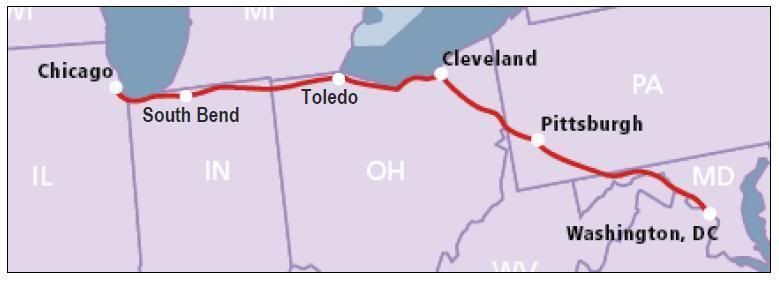 The third route on the list brings us back to the East Coast and the faster train connecting Chicago to DC, the Capitol Ltd. 39% of the ridership on this train is end-to-end Chicago/DC. 14% is Chicago/Pittsburgh. 7% is DC/Pittsburgh. 10% is Toledo traffic — 6% to DC, 4% to Chicago. 4% is DC / Cumberland and 4% is Chicago / Cleveland, which leaves 22% of ridership coming from smaller trip markets.
The third route on the list brings us back to the East Coast and the faster train connecting Chicago to DC, the Capitol Ltd. 39% of the ridership on this train is end-to-end Chicago/DC. 14% is Chicago/Pittsburgh. 7% is DC/Pittsburgh. 10% is Toledo traffic — 6% to DC, 4% to Chicago. 4% is DC / Cumberland and 4% is Chicago / Cleveland, which leaves 22% of ridership coming from smaller trip markets.
One reason for the strong demand for DC, Chicago, and Pittsburgh trips is the availability of connections at DC, Chicago, and Pittsburgh. However the Pittsburgh connection, to the Pennsylvanian through to Philadelphia and NYC, involves a late night cross platform transfer with a long layover. Amtrak market research suggests (unsurprisingly) that passengers would much rather stay in the train and have the whole railroad car layover. And that is exactly the focus of the proposed service improvement to the Capitol Limited: eastbound, drop off a diner, coach and sleeper car to be picked up after a multi-hour layover by the Pennsylvanian eastbound, and westbound pick up the same set that was dropped off by the Pennsylvanian westbound.
At present, the Pennsylvanian is a corridor service with a business class car, food service car, and four coaches per set, with two sets, alternating between eastbound and westbound. Under the new plan, two coaches, one food service car, and one sleeper will be in the set of cars that are transferred back and forth, with three sets required total. So the equipment requirement goes up by one food service and two coach cars, because the Chicago through to Philadelphia / NYC route requires three sets of cars, and three sleepers for the sleeper passengers through to Philadelphia/NYC.
Because it is primarily longer distance passengers that are affected by the change, the passenger miles are projected to ride more than the ridership, with 9% higher ridership but 17% more passenger miles. With the addition of a new sleeper service option, revenue rise even further, by 21%. Avoidable Cost Recovery from passenger revenues rises from 47% to 51% of avoidable costs. Costs increase by 11% but, of course, at 47% cost recovery, 11% increase in costs is more money than 21% increase in revenue, so total subsidy is projected to increase by $0.7m.
California Zephyr and Wrapping It Up
And the Zephyr? As far as operations go, they had close to nothing, so the Working Group focused on how to raise the performance of the customer service crews generating the least praise and most complaints to be more like the crews generating the most praise and fewest complaints. Of course, if they simply shift them in the direction of the crews that generate few complaints or praise, that ought to increase their Customer Satisfaction Index as well.
The only operational change they could come up with was shifting one coach off of the large number of sets that provide this service in the wintertime, when demand is lower, and placing them into increased service between Reno and San Francisco, when the roads to Reno are more dangerous to drive, and when accommodating all of the Reno passenger demand would imply leaving a large number of coach seats empty east of Reno.
But realistically, the only thing that can provide a substantial increase in financial performance and on time performance along the California Zephyr route is some sort of Rapid Passenger Rail upgrade along some substantial stretch of the corridor between Chicago and Denver, such as between Chicago and Omaha for the Iowa Connection. The Zephyr has a 52 hour schedule, with the eastbound scheduled into Chicago 20mins after the westbound is scheduled to depart, and the eastbound scheduled to leave 17 hours after the westbound arrives in Oakland. Two to three hours removed from the Chicago to Denver leg of the journey would allow a train to arrive in Chicago and turn around to return the same day, as well as providing an arrival closer to start of business and a departure at about close of business.
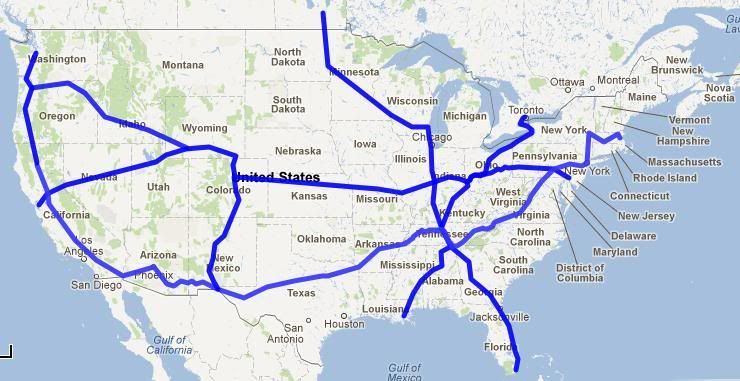 Which brings me back to the Steel Interstate plan discussed last week. While the routes were drawn up in pursuit of freight rail markets, each of the five struggling corridors would gain a benefit from the Steel Interstate routes sketched to the right. The Cardinal would gain a higher speed run from Cincinnati to Indianapolis, which doesn’t seem like much. However, there is also a rail corridor connecting from Lafayette to the Eastern Illinois corridor, so with a re-routing it could well run on a Steel Interstate for over half the distance between Cincinnati and Chicago. The Capitol Ltd would not gain a path on a Steel Interstate. However, its planned partner service the Pennsylvanian would, allowing multiple Pittsburgh / Philadelphia / NYC services per day, and so allowing a much shorter layover in Pittsburgh for the through service to NYC, as well as a much faster trip. The California Zephyr would gain a ride on the Steel Interstate from Salt Lake City through to Oakland, likely cutting over half a day from the service time.
Which brings me back to the Steel Interstate plan discussed last week. While the routes were drawn up in pursuit of freight rail markets, each of the five struggling corridors would gain a benefit from the Steel Interstate routes sketched to the right. The Cardinal would gain a higher speed run from Cincinnati to Indianapolis, which doesn’t seem like much. However, there is also a rail corridor connecting from Lafayette to the Eastern Illinois corridor, so with a re-routing it could well run on a Steel Interstate for over half the distance between Cincinnati and Chicago. The Capitol Ltd would not gain a path on a Steel Interstate. However, its planned partner service the Pennsylvanian would, allowing multiple Pittsburgh / Philadelphia / NYC services per day, and so allowing a much shorter layover in Pittsburgh for the through service to NYC, as well as a much faster trip. The California Zephyr would gain a ride on the Steel Interstate from Salt Lake City through to Oakland, likely cutting over half a day from the service time.
And the “Texas Eagle Limited” would get a ride on the Steel Interstate from Los Angeles through to El Paso.
All of these are aside from newly established services, at the trip speeds of 70mph that allows a long distance train to cover costs out of revenue, running entirely along the the Steel Interstates.
The things about a long haul sleeper service is that on an trip of over a day in length, one must eat, one must relax and, of course, one must sleep.
While driving, the eating is normally done while parked, just as a break from driving. The relaxation is replaced by the activity of chauffeuring yourself, which ought to include (but, as we know from the annual highway death toll, often does not include) “rest” breaks every few hours to convince your body that it is in fact in use and should not take a nap. And, of course, sleeping while driving quickly most often results in not driving any more that day, if ever.
On the long haul sleeper, the eating, the relaxation, and the sleeping, can all be done while the train is in motion. If you need a break from sitting in your seat, you can go to the lounge car. If you are a reader, rather than listening to an audio book while driving, you can sit down and read a book. If its an ebook, you can plug your ereader in. The next best is a good sleeper bus, as in South America, but even the best sleeper bus has no diner car and no lounge car.
Indeed, if we pursue the Steel Interstates (as we will do if we ever gain freedom from our economic bondage to Big Oil), one way that we will be able to provide intercity transport services to cities and towns that would otherwise have none is to run a conventional rail sleeper service through town, then sooner or later hit the Steel Interstate, and lay the passenger cars over to be picked up by the electric Steel Interstate passenger train running through. Even an hour or so layover will quickly be made up by the speed of the Steel Interstate service and, of course, if one wishes one can sleep, or read, or watch a movie straight through the layover without having to get out of the train and wait. One could, indeed, go to get a sandwich while the train is stopped, and have the train get picked up and begin moving before your sandwich is finished.
Which is a key advantage of the Steel Interstates for freight, translated directly to passenger rail. The existing Amtrak passenger rail cars are already capable of 110mph service, if they can get a 110mph corridor on which to run. With the financial performance of passenger rail along a Steel Interstate, we can be confident of two or three daily long distance trains along the Steel Interstates. And with two or three long distance trains running along a given Steel Interstate, there will be the opportunity to run a short,. Cardinal style, sleeper train in many routes through the country scheduled to then be collected later in the evening by a through Steel Interstate service, with the passengers 900 miles along the line within half a day.
Midnight Oil ~ Beds Are Burning
That is, if you can sleep while our beds are burning.

1 comments
Author
… after we let it slip away, that is a journey of some few miles itself.